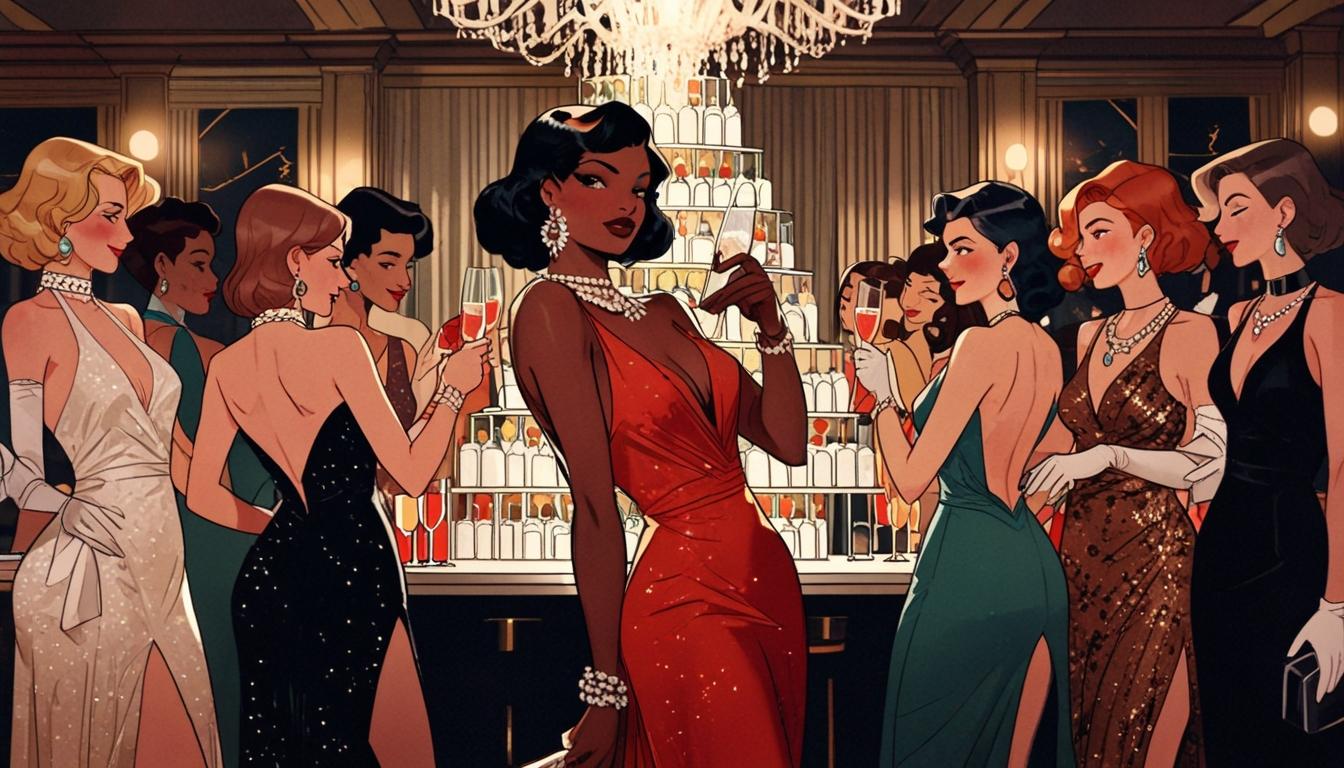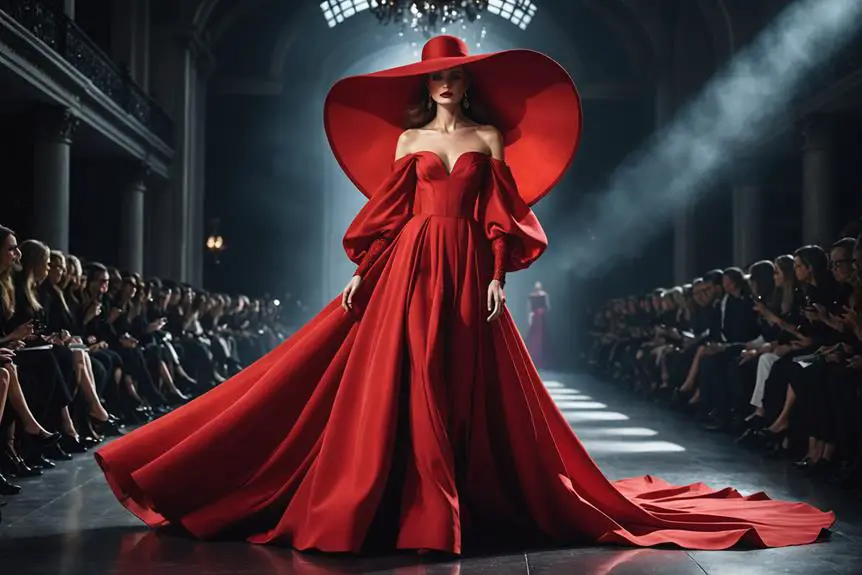You might find it intriguing how Marlene Dietrich's fashion choices not only defined her persona but also challenged societal norms of her time. By embracing androgyny and making bold statements with her clothing, she blurred the lines of gender in a way that still resonates today. From her iconic trousers to her extravagant costumes in films, each moment crafted a narrative that was both personal and cultural. What you'll discover next is how her influence stretches beyond the silver screen and into contemporary fashion, reshaping the conversation around identity and style.
Early Life and Fashion Beginnings
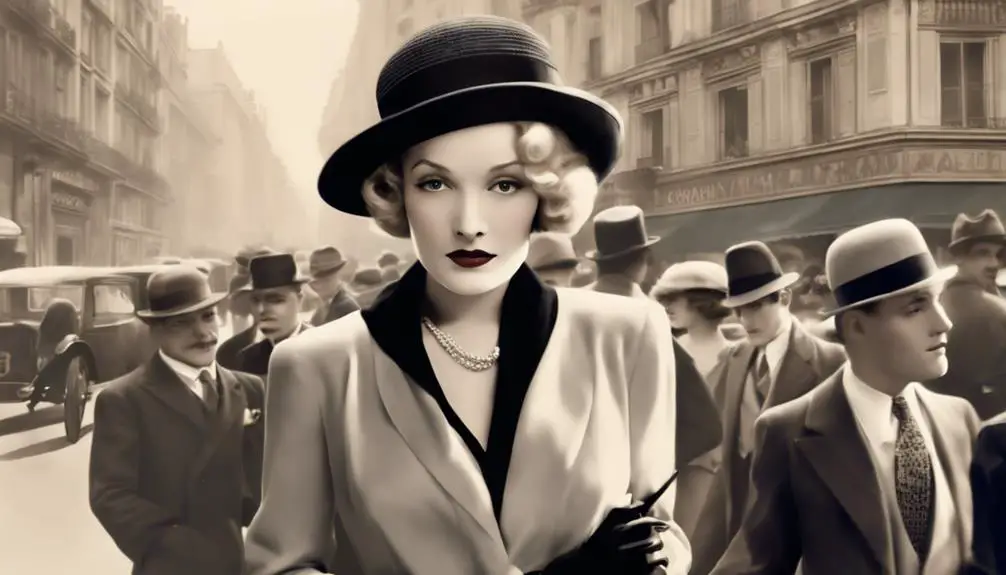
Marlene Dietrich, born Marie Magdalene Dietrich in 1901, commenced her artistic journey through rigorous home tutoring in ballet, violin, and piano. These early experiences laid the foundation for her remarkable career, but a wrist injury shifted her focus from music to acting. This shift led to her breakout role in "The Blue Angel," where her unique style captured the attention of audiences and critics alike.
After moving to the United States in 1930, you'd quickly notice how Dietrich's bold fashion choices set her apart. She pioneered androgynous looks that blended femininity and masculinity, showcasing her fearless approach to style.
Her wardrobe was marked by luxurious fabrics, including sumptuous furs and impeccably tailored suits, which helped redefine women's fashion norms during that era.
What's truly fascinating is how Dietrich dressed primarily for herself, reflecting her desire to challenge societal expectations. Her early fashion choices not only expressed her individuality but also inspired generations of women to embrace their own unique styles.
With her lasting influence, Marlene Dietrich remains a timeless icon who revolutionized the way we perceive fashion and self-expression.
Androgyny and Gender Norms
During the early 20th century, Marlene Dietrich emerged as a groundbreaking figure in fashion, challenging the rigid gender norms of her time. She was the first Hollywood actress to wear trousers in public, boldly stepping into a domain that many women feared to explore.
Dietrich's androgynous style was pivotal, blending elements of masculinity and femininity with her tailored pants and three-piece suits, influencing fashion trends for generations to come.
One of her most memorable moments was donning an all-white suit in 1933, which was considered scandalous yet stunning. This choice showcased her fearless approach to fashion, as she embraced statement pieces like chic hats and luxurious fabrics, further blurring the lines between traditional gendered clothing.
Dietrich's mantra, "I dress for myself," highlights her commitment to self-expression over societal expectations, empowering countless individuals to embrace their unique styles.
Iconic Film Roles and Costumes
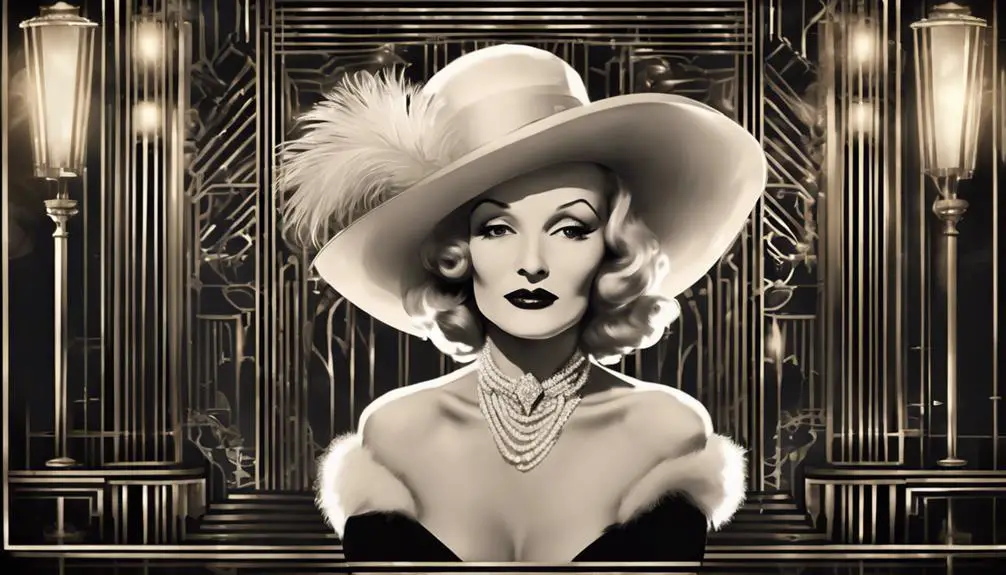
Iconic film roles often define an actress's legacy, and Marlene Dietrich's performances are no exception. Her portrayal of Lola Lola in "The Blue Angel" (1930) introduced you to a sultry look that solidified her status as a cinematic sex symbol.
In "Shanghai Express" (1932), you'll admire her glamorous cabaret singer, adorned in luxurious fabrics designed by Travis Banton, which perfectly showcased her androgynous style and intricate detailing.
In "The Devil is a Woman" (1935), Dietrich wowed audiences in a memorable two-tone silk dress with oversized sleeves, exemplifying bold fashion and dramatic femininity.
You can't overlook her iconic role in "Blonde Venus" (1932), where she challenged traditional gender norms with a stunning sequined gown and a daring tailored pantsuit, influencing women's fashion choices for generations.
Perhaps most strikingly, in "Morocco" (1933), Dietrich donned a tuxedo and shared a kiss with a woman, marking a significant moment in cinematic history.
Through these iconic roles and costumes, Marlene Dietrich didn't just act; she became a groundbreaking fashion icon and a true femme fatale, forever changing the landscape of women's representation in film.
Statement Sleeves and Bold Fashion
The emergence of statement sleeves in fashion can be largely attributed to Marlene Dietrich's daring style choices. Her iconic looks often featured oversized proportions that created a bold visual impact, making her a true pioneer in the world of fashion.
One standout moment was her two-tone silk dress from the film "The Devil is a Woman," where dramatic oversized sleeves highlighted the artistry of proportion in design. You can see how Dietrich's fashion legacy continues to thrive today, as modern designers reinterpret statement sleeves in various fabrics and designs, incorporating bold colors and patterns that echo her original looks.
These statement sleeves not only emphasize elegance but also contribute to the allure of feminine dresses, allowing wearers to express their individuality and confidence.
Dietrich's androgynous style challenged conventional norms, paving the way for future generations of fashion icons. By embracing these bold elements, you're not just making a fashion statement; you're honoring the influence of Marlene Dietrich.
Cultural Impact on Women's Fashion
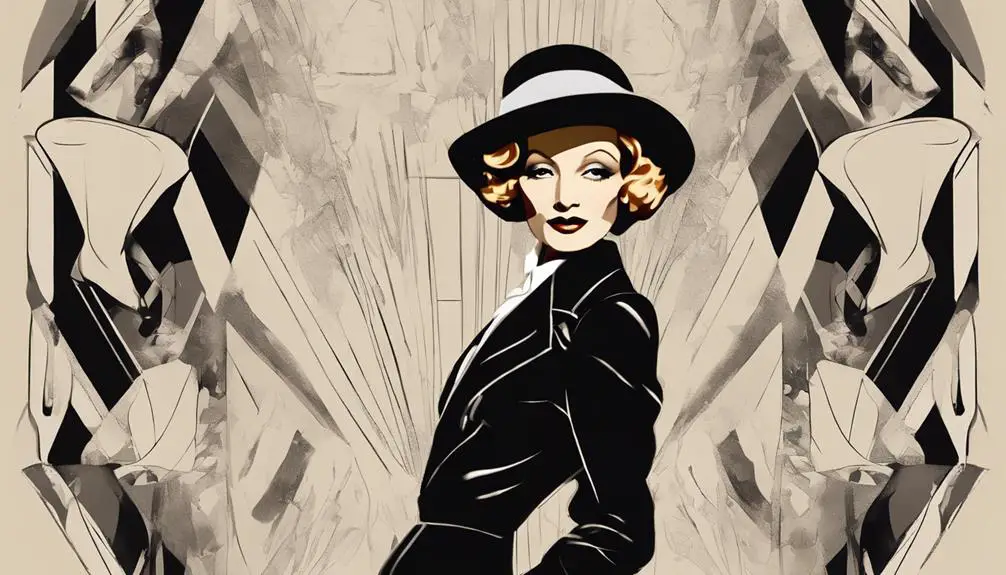
With her groundbreaking fashion choices, Marlene Dietrich reshaped women's clothing and challenged societal norms. As the first Hollywood actress to wear trousers in public, she defied traditional gender expectations, paving the way for women's acceptance of pants in everyday fashion. Her androgynous style, marked by tailored suits and masculine clothing paired with glamorous accessories, considerably influenced the evolution of women's fashion in the early 20th century.
Dietrich's bold fashion choices, including her iconic all-white suit from 1933, sparked crucial conversations about femininity and masculinity in clothing. By embracing a more fluid approach to style, she encouraged women to experiment with their fashion, blending masculinity with femininity to create a unique aesthetic. This empowerment allowed women to express their individuality through clothing, inspiring future generations of female icons who followed in her footsteps.
Moreover, her use of luxurious fabrics and expert craftsmanship set a new standard for elegance in women's fashion. Dietrich's cultural impact continues to resonate, influencing designers and styles that persist in contemporary wardrobes, proving that her legacy is as timeless as it's groundbreaking.
Modern Interpretations of Dietrich's Style
Marlene Dietrich's revolutionary approach to fashion continues to inspire modern designers, who reinterpret her androgynous looks for today's wardrobes. As a style icon, Dietrich broke boundaries with her bold fashion choices, and today's contemporary collections echo that fearless spirit.
Designers often draw on her signature elements, such as tailored suits and luxurious fabrics, creating pieces that challenge traditional gender norms. Statement sleeves, reminiscent of Dietrich's daring silhouettes, find new life in various fabrics, emphasizing elegance and femininity while paying homage to her aesthetic.
Current trends also embrace bold colors and patterns, reflecting Dietrich's fearless approach to personal style, which remains timelessly chic. You might notice that celebrities often channel Dietrich's influence on the red carpet, donning androgynous outfits that highlight her lasting impact on fashion.
The revival of androgynous fashion in modern wardrobes encourages creativity and self-expression, inviting everyone to explore their unique interpretations of Dietrich's iconic looks. By embracing her innovative spirit, you can celebrate the beauty of bold fashion while making a statement that resonates with today's dynamic style landscape.
Notable Fashion Exhibitions
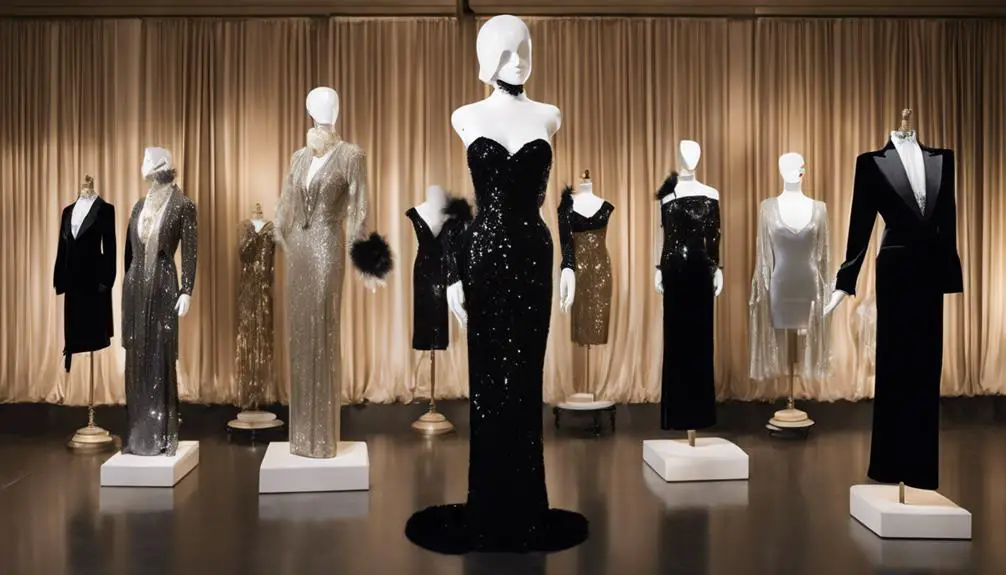
Fashion enthusiasts won't want to miss the exhibition "Play the Part: Marlene Dietrich" at the International Center of Photography in New York City, running until January 8, 2024.
This enthralling exhibition showcases approximately 250 photographs from 1906 to 1978, highlighting both Dietrich's public persona and her off-camera moments. You'll find stunning works by iconic photographers like Irving Penn, Richard Avedon, and Cecil Beaton, offering a diverse array of images that capture the essence of her style.
One of the exhibition's main focuses is Dietrich's groundbreaking fashion choices, which boldly challenged gender norms of her time.
Take a closer look at her famous pantsuits and luxurious outfits, including her remarkable all-white suit from 1933 and a pleated two-piece from 1939, both showcasing her innovative approach to fashion.
Organized by Haley Kane, the exhibition doesn't just celebrate Dietrich's style; it also illustrates her significant influence on women's fashion in the film industry.
You'll leave with a deeper understanding of how Marlene Dietrich redefined elegance and power through her iconic fashion moments, forever changing the landscape of style.
Legacy and Influence on Designers
The impact of Marlene Dietrich's style extends far beyond her own time, resonating through the work of countless designers today. Her pioneering androgynous style, particularly her bold use of trousers and menswear, has inspired numerous contemporary fashion innovators to weave gender-fluid elements into their collections.
You'll often find designers referencing Dietrich's iconic outfits, like her tailored suits and dramatic statement sleeves, which have been reimagined in various modern interpretations on runways.
The luxurious fabrics and expert craftsmanship that characterized Dietrich's wardrobe continue to set benchmarks for quality and elegance. Her daring fashion choices, including her love for fur and structured silhouettes, have sparked a revival of classic glamour in contemporary fashion, appealing to a new generation of style icons enthusiastic to embrace her legacy.
Dietrich's influence is palpable in ongoing discussions about gender and identity in fashion, as designers draw from her aesthetic to challenge traditional norms and promote self-expression.
Frequently Asked Questions
What Was Marlene Dietrich Famous For?
You'll find Marlene Dietrich famous for her groundbreaking films, unique fashion sense, and striking style. Her influence on gender norms and legacy in Hollywood earned her numerous awards, solidifying her status as a fashion and film icon.
How to Dress Like Marlene Dietrich?
To dress like Marlene Dietrich, embrace vintage glamour with tailored suits and an androgynous style. Incorporate bold accessories, channel classic Hollywood vibes, and aim for timeless elegance that captures her iconic essence effortlessly.
Was Marlene Dietrich a Feminist?
Yes, Marlene's influence sparked a style revolution, challenging gender norms and embodying the femme fatale in Hollywood glamor. Her emphasis on personal empowerment through fashion truly redefined women's roles and expressions in society.
What Did Marlene Dietrich Do During World War II?
During World War II, you'd find Marlene Dietrich engaging in wartime performances, boosting morale for troops. Her Hollywood influence extended to espionage activities and refugee support, showcasing her commitment to the entertainment industry's role in the war effort.


